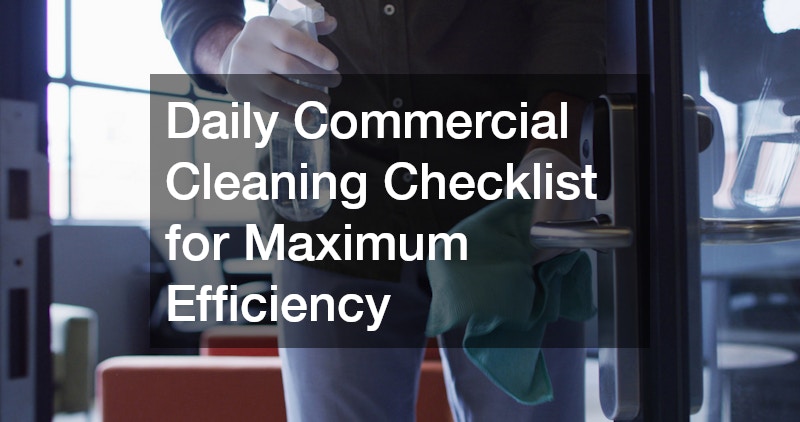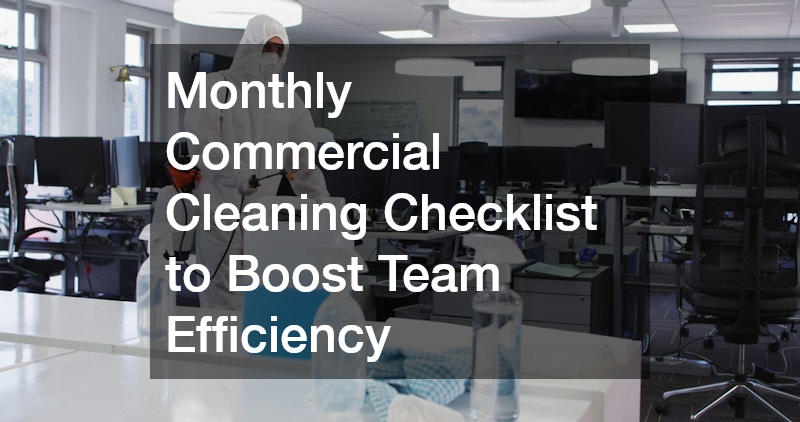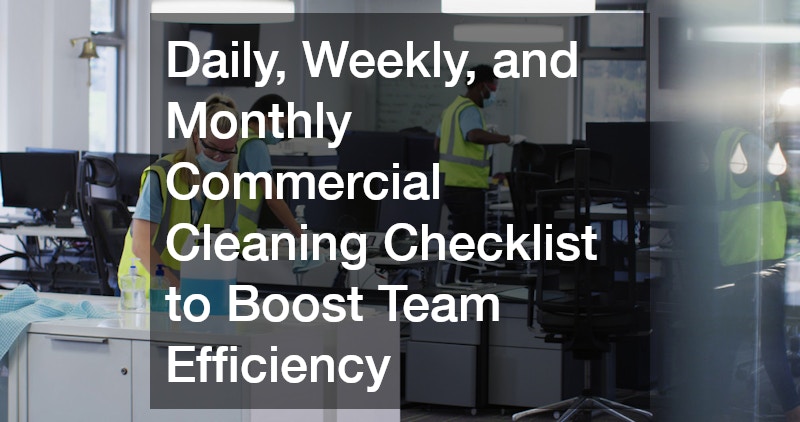
Cleanliness in a commercial space is more than just about appearance—it’s about productivity, safety, and employee morale. A well-organized cleaning routine ensures that every corner of your office, retail store, restaurant, or facility remains presentable and functional. However, without a structured plan, cleaning tasks can become inconsistent and inefficient, leading to wasted time and overlooked areas.
This is where a clear daily, weekly, and monthly commercial cleaning checklist becomes invaluable. By defining what needs to be done, when it should be done, and by whom, you can streamline your team’s workflow and maintain high standards of hygiene.
In this guide, we’ll break down specific cleaning tasks for each time frame, explain why they matter, and show you how to implement them to maximize efficiency and accountability in your workplace.
Why a Structured Commercial Cleaning Schedule Matters
A commercial space sees constant foot traffic, equipment use, and employee activity, making it prone to dirt buildup, spills, and clutter. Without a structured schedule, cleaning often becomes reactive rather than proactive, only happening when an issue becomes visible or disruptive.
A checklist-based cleaning approach offers several benefits:
- Consistency – Ensures all areas are cleaned at the right frequency.
- Efficiency – Reduces wasted time by providing clear task assignments.
- Accountability – Makes it easy to track what’s been done and by whom.
- Compliance – Helps meet industry-specific hygiene standards, particularly in food service, healthcare, and hospitality.
- Employee Morale – Creates a pleasant environment, which can boost productivity and reduce sick days.
A well-structured cleaning plan doesn’t just keep your space spotless—it keeps your business running smoothly.
Daily Commercial Cleaning Checklist for Maximum Efficiency

Daily cleaning tasks are essential for maintaining a healthy and presentable workplace. These are the non-negotiables—activities that prevent the rapid buildup of dirt and germs, ensuring your facility remains welcoming for clients and safe for staff.
Daily cleaning helps avoid deep cleaning emergencies and maintains a baseline of cleanliness that makes weekly and monthly tasks much more manageable. Think of it as “maintenance cleaning”—quick, targeted actions that protect your investment in the workspace.
Essential Daily Cleaning Tasks
Here’s what should be done every single day, ideally during low-traffic hours or after business operations close:
- Reception & Lobby Areas
- Sweep and mop floors.
- Wipe down reception counters and coffee tables.
- Sanitize door handles, elevator buttons, and shared touchpoints.
- Workstations & Offices
- Empty trash bins and replace liners.
- Wipe down desks, keyboards, and phones with disinfectant wipes.
- Organize loose papers or supplies.
- Restrooms
- Disinfect toilets, sinks, and countertops.
- Restock soap, paper towels, and toilet paper.
- Mop floors with a sanitizing solution.
- Kitchen & Break Room
- Clean and sanitize countertops, sinks, and appliances.
- Wipe down tables and chairs.
- Empty and disinfect the trash and recycling bins.
- High-Touch Surfaces
- Light switches, railings, door handles, and shared equipment.
Efficiency Tip
Assign specific daily zones to team members so no area is overlooked. Use a sign-off sheet to confirm completion.
Weekly Commercial Cleaning Checklist to Maintain Quality
Weekly tasks are designed to go beyond surface-level cleaning and target areas that may not need daily attention but still require regular upkeep. By setting aside a designated day for deeper cleaning, you ensure that your facility remains in excellent condition without overburdening staff.
Weekly cleaning bridges the gap between daily touch-ups and monthly deep cleans. It’s also a great opportunity to check for small maintenance issues—like leaks, damaged flooring, or faulty lighting—that could become bigger problems if ignored.
Essential Weekly Cleaning Tasks
- Floors
- Vacuum carpets thoroughly, including under desks and chairs.
- Deep mop hard floors with appropriate cleaning solutions.
- Spot-clean stains before they set.
- Furniture
- Wipe and sanitize office chairs, especially armrests.
- Clean upholstery using fabric-safe cleaners.
- Polish wooden furniture and surfaces.
- Windows & Glass
- Clean interior glass and mirrors for streak-free clarity.
- Wipe down window frames and sills.
- Restrooms
- Scrub grout lines and tiles.
- Deep-clean under sinks and behind toilets.
- Break Rooms
- Clean inside microwaves, refrigerators, and coffee machines.
- Sanitize cupboard handles and drawers.
- Miscellaneous
- Dust vents, light fixtures, and ceiling fans.
- Disinfect shared electronics like printers and copiers.
Efficiency Tip
Bundle weekly tasks into one cleaning shift rather than spreading them throughout the week to reduce interruptions during business hours.
Monthly Commercial Cleaning Checklist to Boost Team Efficiency

Monthly cleaning tasks focus on deep cleaning and preventive maintenance. These aren’t just cosmetic—they can extend the life of furniture, flooring, and equipment, saving you money in the long run. This stage also ensures your workspace maintains a high professional standard for clients, partners, and employees.
Monthly cleaning often involves specialized equipment or extra time, so plan ahead to schedule these tasks during weekends or after hours to avoid operational disruptions.
Essential Monthly Cleaning Tasks
- Carpet & Upholstery Care
- Steam clean carpets to remove embedded dirt and allergens.
- Deep clean upholstered chairs and couches.
- Hard-to-Reach Areas
- Clean ceiling corners, baseboards, and behind large furniture.
- Dust and sanitize high shelves and storage areas.
- Walls & Doors
- Wash walls to remove scuff marks and fingerprints.
- Polish door handles and hardware.
- Equipment & Appliances
- Perform thorough cleanings on large appliances, vending machines, and HVAC units.
- Inspect and clean air filters for better indoor air quality.
- Outdoor Areas
- Sweep and pressure wash entryways.
- Clean signage and exterior windows.
Efficiency Tip
Use the monthly checklist as a chance to assess overall cleanliness standards and make adjustments to daily and weekly routines based on observed trends.
How to Implement and Maintain a Cleaning Checklist System
Having a cleaning checklist is only effective if it’s implemented consistently and followed by everyone. The success of this system lies in clear communication, training, and accountability.
Steps to Implement
- Define Responsibilities – Assign daily, weekly, and monthly tasks to specific individuals or teams.
- Train Staff – Demonstrate proper cleaning methods and safe handling of cleaning agents.
- Post Checklists – Place visible checklists in supply closets or break rooms.
- Track Progress – Use sign-off sheets or digital task management tools.
- Review Regularly – Evaluate effectiveness and make necessary adjustments.
Efficiency Tip
Rotate responsibilities periodically to prevent task fatigue and ensure all staff are cross-trained.
Common Mistakes to Avoid in Commercial Cleaning Routines
Even with a great checklist, businesses sometimes make errors that can slow down cleaning efforts or reduce effectiveness.
- Overloading One Person – Spread tasks evenly to avoid burnout.
- Neglecting High-Touch Areas – These can be germ hotspots if overlooked.
- Using the Wrong Cleaning Agents – Can damage surfaces or pose safety risks.
- Skipping Deep Cleaning – Neglecting monthly tasks can cause long-term wear and tear.
- Failing to Restock Supplies – A cleaning routine is useless without the right tools and materials.
Avoiding these mistakes ensures your cleaning schedule stays on track and delivers consistent results.
Benefits of Using a Commercial Cleaning Checklist to Boost Team Efficiency
A structured cleaning plan directly impacts productivity and workplace culture.
Key benefits include:
- Time Savings – Eliminates confusion and reduces downtime between tasks.
- Higher Quality Standards – Ensures no detail is overlooked.
- Improved Morale – Employees appreciate a clean environment.
- Better Client Impressions – Clean spaces project professionalism.
- Cost Efficiency – Preventive cleaning reduces repair and replacement costs.
How to Train Your Team for Effective Commercial Cleaning
Even the best commercial cleaning checklist won’t be effective without proper training. A well-trained team not only works faster but also maintains higher cleaning standards, which directly impacts workplace safety and presentation. Training should cover both the technical side of cleaning and the organizational skills needed to follow the schedule efficiently.
Key training areas include:
- Proper Use of Cleaning Tools and Equipment – Ensure staff know how to operate vacuums, steam cleaners, and floor polishers safely.
- Chemical Safety – Teach correct mixing, handling, and storage of cleaning agents.
- Time Management – Show how to prioritize tasks based on the checklist.
- Attention to Detail – Train staff to spot overlooked areas, such as under furniture or behind doors.
- Hygiene Practices – Reinforce handwashing, glove use, and proper disposal of waste.
A one-time training session is not enough—regular refreshers keep standards high and prevent complacency.
Tools and Supplies Every Commercial Cleaning Team Should Have
Even the most motivated cleaning crew can struggle without the right tools. Equipping your team with high-quality, appropriate supplies speeds up cleaning tasks and ensures better results. Inadequate or worn-out equipment can lead to incomplete work, inefficiency, and even safety hazards.
Essential tools and supplies include:
- Microfiber Cloths and Mops – For effective dust and dirt removal without scratching surfaces.
- High-Quality Vacuum Cleaners – Preferably with HEPA filters for improved air quality.
- All-Purpose Cleaners – Suitable for various surfaces to reduce the number of products needed.
- Disinfectants – For high-touch surfaces to reduce the spread of germs.
- Protective Gear – Gloves, masks, and goggles for safety.
- Organized Cleaning Caddies – To keep tools accessible and reduce downtime.
Regularly inspecting and maintaining these supplies prevents breakdowns and keeps your cleaning schedule on track.
Final Thoughts
For business owners and managers, a daily, weekly, and monthly commercial cleaning checklist isn’t just a “nice-to-have”—it’s a powerful tool for efficiency, hygiene, and workplace satisfaction. By breaking down tasks into manageable intervals, you ensure consistent cleanliness without overburdening your team.
Remember, the best cleaning routine is one that’s realistic, easy to follow, and adaptable to your business’s unique needs. Whether you manage a corporate office, a retail store, or a busy restaurant, investing in a structured cleaning plan will keep your operations running smoothly and your workspace looking its best year-round.


